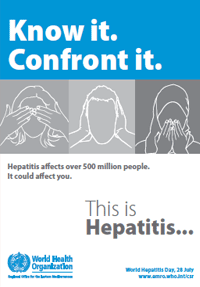 Hepatitis viruses A, B, C, D and E can cause acute and chronic infection and inflammation of the liver that can lead to cirrhosis and liver cancer. The world is celebrating World Hepatitis Day on 28 July. The global theme of the day is “This is hepatitis. Know it. Confront it”. The day also marks the birthday of Professor Baruch S. Blumberg who discovered the hepatitis B virus. In accordance with World Health Assembly (WHA) resolution WHA 63.18, the Day was first celebrated last year across the globe to raise public awareness on the risk and burden of viral hepatitis for individuals and communities and also to strengthen prevention and control efforts of viral hepatitis and its related disease.
Hepatitis viruses A, B, C, D and E can cause acute and chronic infection and inflammation of the liver that can lead to cirrhosis and liver cancer. The world is celebrating World Hepatitis Day on 28 July. The global theme of the day is “This is hepatitis. Know it. Confront it”. The day also marks the birthday of Professor Baruch S. Blumberg who discovered the hepatitis B virus. In accordance with World Health Assembly (WHA) resolution WHA 63.18, the Day was first celebrated last year across the globe to raise public awareness on the risk and burden of viral hepatitis for individuals and communities and also to strengthen prevention and control efforts of viral hepatitis and its related disease.
Viral hepatitis is a group of diseases causing inflammation of the liver. There are five main types of hepatitis virus - A, B, C, D and E. Hepatitis is a potentially fatal disease. Many people experience no symptoms if left untreated. The danger and extent of hepatitis as a threat to public health is largely being ignored in the world. More needs to be done to stop this “silent epidemic”.
Although the burden of disease caused by viral hepatitis is growing, the problem remains largely ignored or unknown to many policy-makers, health workers and the public. Viral hepatitis affects 1 in every 12 people worldwide. Current estimates indicate that viral hepatitis is the eighth leading cause of death worldwide, causing close to 1 million deaths every year, on a par with deaths caused by HIV/AIDS or diarrhoeal diseases, and more than the number caused by tuberculosis and malaria.
Viral hepatitis caused by hepatitis A and E viruses is typically caused by ingestion of contaminated food and water. On the other hand, hepatitis B, C and D are spread by infected body fluids, including blood or blood products, contaminated medical equipment, by sexual contact and from mother-to-child during birth. In particular, hepatitis B and C often lead to chronic infection, and are the most common cause of liver cirrhosis and cancer.
All types of viral hepatitis (A, B, C, D and E) occur throughout the Eastern Mediterranean Region (Table 1). Some countries in the Region have higher infection rates for hepatitis C and hepatitis E than any other country in the world. The prevalence rate of chronic viral hepatitis (hepatitis B and C virus infection) in the Eastern Mediterranean Region is one of the highest in the world ranging from 2% to 10%. Civil unrest and conflict have undermined the health systems in many countries in the Region. The Region has seen many explosive outbreaks of hepatitis E and A in countries with large number of internally-displaced populations and refugees with inadequate sanitation.
Table 1. Burden of viral hepatitis in the Eastern Mediterranean Region
|
Hepatitis A |
Unknown. Mostly associated with contaminated water and food |
|---|---|
|
Hepatitis B |
More than 170 000 000 people are chronically infected and approximately 4.3 million new infections occur every year |
|
Hepatitis C |
Some 17 000 000 to 21 000 000 people are chronically infected and approximately 800 000 new infections occur every year in the Region. Most infections are acquired in health care settings. |
|
Hepatitis D |
Unknown. Both super-infection and co-infection occur with hepatitis B virus |
|
Hepatitis E |
Unknown. Explosive outbreaks have been seen in many countries in the Region. Infection in pregnancy is associated with a high risk of complications, including deaths. |
Hepatitis is a preventable disease and can be eliminated within our lifetime. Effective and cheap vaccines are available that can provide life long protection from hepatitis B infection. On the other hand, Hepatitis C is a curable disease. The chronic nature of the hepatitis B and C calls for strong focus on screening, care and treatment. With early detection and appropriate management, the quality of life of millions of people living with this disease can be improved.
World Hepatitis Day is an opportunity to focus attention on what can be done for prevention and control of viral hepatitis. Government, civil society, nongovernmental organizations, academia, patient groups and health professionals need to combine efforts to confront and combat this silent epidemic.
A Global Policy Report for the Prevention and Control of Viral Hepatitis has also been published, including a review of the situation in the Eastern Mediterranean Region.
Related links
Global Policy report for prevention and control of viral hepatitis
Posters
Hepatitis affects over 500 million people. It could affect you | Arabic | French
Hepatitis affects over 500 million people. It could affect you | Arabic | French








